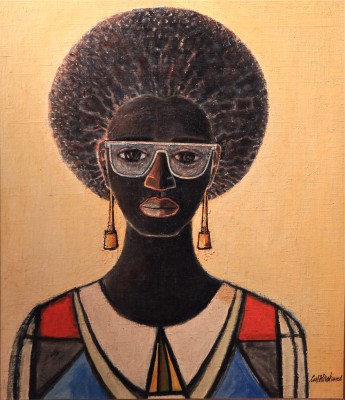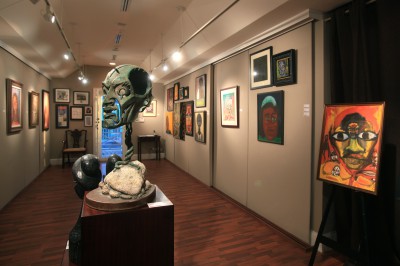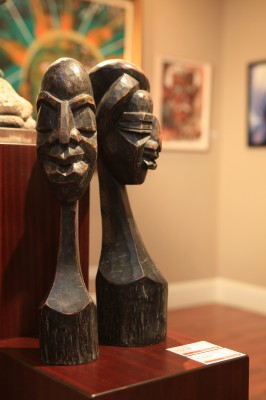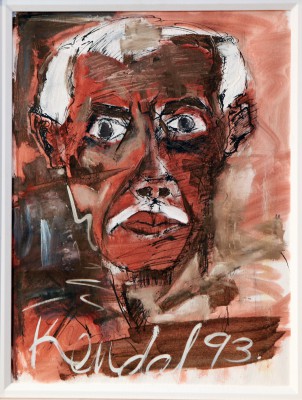Fix Ya Face
11/22/2012-01/17/2013
When I began to choose the
work for “Fix Ya Face!” I approached it with the idea that any image which
alludes to the likeness of a face could be considered a portrait. Little did I
know, as John Gere states, art historians and critics have come to define a
portrait as an image “in which the artist is engaged with the personality of
his sitter and is preoccupied with his or her characterisation as an
individual.” This took me by surprise. My definition of portrait, apparently
not an academic one, completely misled me to select all of the pieces for “Fix
Ya Face!” with them in mind as “portraits”. Upon review, however, it would
appear that out of the thirty-six selected artworks, only four are portraits.
Inevitably, I learned that this was not the portrait exhibition I thought it
was going to be and the solution to my ignorance stood plainly in front of my
own face the entire time. “Fix Ya Face!” is an exhibition of faces.
“Fix Ya Face!” addresses the many ways in which Bahamian
and a few international artists alike have defined the face in art. It is an
exploration of imagination and process, a display of influence, thought and
preservation of the ideals of beauty held by the few artists we have represented
in this exhibition. Furthermore, we have used the common autocratic Bahamian
colloquialism “Fix ya face!” as a way to discuss such ideals of beauty in the
Bahamian context. This body of work explores the diverse methods of portraying
the face and the possible reasoning behind them. For some, addressing this
issue may appear as an age-old and unnecessary discussion. However, many
individuals are unable to appreciate the different types of art available
outside of realism and hyper-realism so it is quite necessary that such a
conversation continue to take place for the sake of exposure—and the human face
is an accessible object through which to examine a cross-section of artistic
practices.
An artist in this exhibition who definitely moves beyond
the social “norm” of realism is Mr. Kendal Hanna whose work I believe artists
and viewers are most fortunate to be able to witness, particularly because of
his contributions to abstract-expressionism in the Bahamian art community.
Hanna’s generally loose style nonetheless makes for pieces with a strong
presence and compositions that are nothing less than ‘on-point’. As one of two
of Hanna’s pieces in “Fix Ya Face!”, “Mask of Girl” is a combination of ink and
oil paint on a canvas which has been folded several times in a method adopted
from the Rosharch test. Despite the lack of realistic detail this dark sort of silhouette
portrayed here suggests that this is indeed some type of mask. Considering
individuals around us have the opportunity to read into our personalities
through our many expressions, it would seem only right to cover up the face at
times so as to shield it from public viewing. Sometimes seeing all of the many
well-designed features of a face in an art piece is not necessary, just as it
seems inevitable that at some point or another one would much prefer to erase
some of the wrinkles of pain and fear and simply pass through a crowd not being
seen at all, just for a sense of escape.
A piece within this exhibition which so easily contrasts
Kendal Hanna’s “Mask of Girl” is Matthew Wildgoose’s caricature of famed
Bahamian musician Joseph Spence, suitably titled “Mr. Spence”. Wildgoose is
known in the Bahamian art community as one of few artists who successfully captures
the personalities of many prominent figures of this nation’s history and
present-day affairs. Whether it is an illustration of Pindling posing
heroically as a boxer or a play on one of many Bahamian artists, you can always
expect Wildgoose to filter out the true essence of his subjects.
Unlike most of the pieces in this exhibition, “Mr.
Spence” truly fits the definition of a portrait. Using acrylic paint along a tightly
woven canvas, Wildgoose gives us a representative image of Joseph Spence in character:
a man focused on the strings of his guitar, holding between succulent lips a
supposedly unlit smoking pipe, probably armed with fresh tobacco, ready to
“fire” away at the burst of musical strings. Although the artist has Mr. Spence
focused on his guitar, he has not shown us the musician’s eyes—yet despite the
absence of what Shakespeare might call the “windows to your soul”, spirit still
exudes from this quietly playful piece, reminiscent about days gone by, love
and loss, or simply an island’s cultural relics.
Fortunately enough, the D’Aguilar Art Foundation has
collected from not only Bahamian artists but also artists from quite a handful
of countries globally. One of the international artists represented in “Fix Ya
Face!” is well-known African-American artist and scholar Romare Bearden,
recognized for his many contributions concerning the representation of minority
groups in the United States of America, particularly in reference to persons of
African heritage. Bearden’s “Face
looking to the right” uses broad brushstrokes to create facial features that establish
a person of African heritage. This is probably one of the greatest successes of
this piece as Bearden’s use of semi-abstraction, basic shape and line proves
that hyper-realistic detail of a person in artwork is not necessary when trying
to express feeling or discuss particular topics. Based on Bearden’s definition
of the face in this piece it would appear that subtlety can easily capture both
the emotional and logistical aspects of a subject.
If you walk around the D’Aguilar Art Foundation you are
likely to find a small, framed note written by Vincent D’Aguilar which he would
have carried in his wallet from time to time. The note reads:
Douglas to Bearden
“Technique in itself is not enough.
It is important for the artist to develop the power to convey emotion….The
artist technique, no matter how brilliant it is, should never obscure his
vision.”
It is clear that Romare Bearden was
confident in the advice given to him by Aaron Douglas. The focus on technical
detail does not seem to be necessary when it comes to expressing certain
points. As one may be able to speak to a crowd, they can address them in the
most formal way possible, using words many people in the crowd have never even
heard of before. Logically, this might be a very effective method however the
question at the end of it all might be whether or not the speaker ever actually
touched the hearts of his audience. Once you do that, once you tap into your
audience’s feelings to have them see your point, then you know you have truly
affected them. I have drawn this illustration simply to show that although
Bearden’s “Face looking to the right” is quite a simple piece and an untrained
eye might say, “das somethin’ my chil’
could do”, the work itself can in the same time be quite complex. What seems to
be a simple zig-zag line in the forehead may be a wrinkle to suggest a sense of
confusion and curiosity; so does the sharp diagonal bottom lip that creates a
feeling of tension. Had Bearden produced this piece in an extremely realistic
manner it may not evoke the same feeling it does now. Bearden has managed
to go beyond the surface of the face
itself, giving his viewer the experience of his subject’s emotions. As Bearden
gives his “speech” with this subject the viewer may learn to never judge a book
by its cover. Although a masterfully crafted realistic face can express great
warmth and kindness, we never truly know everything that exists beyond this
façade.
As these few pieces suggest,the thirty-six pieces
included in “Fix Ya Face!” explores the many differences and similarities of
technique and style possessed by twenty-six artists on display. I believe true
style begins somewhere around an idealistic experience which is influenced by
whatever one might define as a realistic experience. The ideal then exists in
one’s thoughts for as short a time as two seconds to as long as twenty years. This
style is then defined when these ideals become manifested in a physical form,
whether in literature, visual art, performing art, and other creative ventures.
Bringing together all of these “styles” of expressing the face will allow people the opportunity to see these methods and gain further
understanding of how or why artwork can be created so differently.




